I was thinking if humans could experience a Quaternary extinction event. Outside of an asteroid or planet hitting the earth like 65 million years ago maybe not. But, I was thinking if a plague that got 94% dead hit at the same time as an ice age hit that might extinct the human race too.
begin quote from:
https://en.wikipedia.org/wiki/Quaternary_extinction_event
Quaternary extinction event
From Wikipedia, the free encyclopedia
|
|
It has been suggested that this article be merged with Holocene extinction. (Discuss) Proposed since January 2016. |
| This article needs additional citations for verification. (August 2015) (Learn how and when to remove this template message) |
Late Pleistocene landscape of northern Spain (left to right- Equus ferus, Mammuthus primigenius, Rangifer tarandus, Panthera leo spelaea, Coelodonta antiquitatis)
Contents
The Pleistocene or Ice Age extinction event
The Late Pleistocene extinction event saw the extinction of many mammals weighing more than 40 kg.- In North America around 33 of 45 genera of large mammals became extinct.
- In South America 46 of 58
- In Australia 15 of 16
- In Europe 7 of 23
- In Subsaharan Africa only 2 of 44
There are three main hypotheses concerning the Pleistocene extinction:
- The animals died off due to climate change associated with the advance and retreat of major ice caps or ice sheets.
- The animals were exterminated by humans: the "prehistoric overkill hypothesis" (Martin, 1967).[3]
- The extinction of the woolly mammoth (by whatever cause, perhaps by humans) changed the extensive grasslands to birch forests, and subsequent forest fires then changed the climate.[4] We now know that immediately after the extinction of the mammoth that birch forests replaced the grasslands and that an era of significant fire began.[5]
Evidence supporting the prehistoric overkill hypothesis includes the persistence of certain island megafauna for several millennia past the disappearance of their continental cousins. Ground sloths survived on the Antilles long after North and South American ground sloths were extinct. The later disappearance of the island species correlates with the later colonization of these islands by humans. Similarly, dwarf woolly mammoths died out on remote Wrangel Island 1,000 years after their extinction on the mainland. Steller's sea cows also persisted in seas off the isolated and uninhabited Commander Islands for thousands of years after they had vanished from the continental shores of the north Pacific.[6]
Alternative hypotheses to the theory of human responsibility include climate change associated with the last glacial period and the Younger Dryas event, as well as Tollmann's hypothetical bolide, which claim that the extinctions resulted from bolide impact(s). Such a scenario has been proposed as a contributing cause of the 1,300 year cold period known as the Younger Dryas stadial.[citation needed] This impact extinction hypothesis is still in debate due to the exacting field techniques required to extract minuscule particles of extra terrestrial impact markers such as Iridium at a high resolution from very thin strata in a repeatable fashion, as is necessary to conclusively distinguish the event peak from the local background level of the marker.[citation needed] The debate seems to be exacerbated by infighting between the Uniformitarianism camp and the Catastrophism camp.[citation needed]
The Chalicothere vanished in the early Pleistocene
Africa and Asia
See also: List of African animals extinct in the Holocene and List of Asian animals extinct in the Holocene
The Old World tropics have been relatively spared by Pleistocene extinctions. Africa and southern Asia
are the only regions that have terrestrial mammals weighing over
1000 kg today. However, during the early, middle and late Pleistocene
some large animal forms disappeared from these regions without being
replaced by comparable successor species. Climate change has been cited
as most likely causing the extinctions in Southeast Asia.[7]
Eucladoceros cranium fossil, Museo di Paleontologia di Firenze
Steppe Mammoth (Mammuthus trogontherii) dimensions
Megantereon restoration
A Pachycrocuta bevirostris reconstruction
The modern Jaguar (Panthera onca), although now restricted to the Americas, originated in Asia, before colonising both sides of Beringia- Europe in the form of the European jaguar, and in the Americas as the predecessors of today's species.
Australopithecus family reconstruction.
Homotherium restoration- although Homotherium were extirpated in Africa 1.5 mya, they had spread throughout Eurasia and the Americas, remaining in South America at least until the Middle Pleistocene, and perishing in all other continents during the late Pleistocene.
Pelagornis sandersi comparison with the Andean condor (Vultur gryphus) and the Wandering albatross (Diomeda exulans)
Steppe bison (Bison priscus) cave art.
Life reconstruction of the extinct Megaloceros
Painting of a Cave Lion (Panthera leo spelaea)
Megalochelys atlas reconstruction
- Giraffids (e.g. Giraffa jumae)
- Paracamelus
- Camelus moreli
- Gazella psolea
- Makapania
- Bos acutifrons
- Chalicotheres (e.g. Ancylotherium, Nestoritherium)
- A few species of warthog such as Metridiochoerus
- Kolpochoerus
- Hippopotamus gorgops (a giant hippopotamus)
- Various members of Equidae
- Assorted members of Cervidae
- Broad fronted moose (Cervalces latifrons)
- Cervavitus
- Eucladoceros
- Libralces
- Various members of the order Proboscidea
- Metaxytherium
- Running hyena (Chasmaporthetes)
- Giant hyena (Pachycrocuta)
- Giant predatory bear (Agriotherium)
- Auvergne bear (Ursus minimus)
- Dwarf panda (Ailuropoda minor) et Ailuropoda wulingshanensis [8]
- Viverra leakeyi
- Canidae sp.
- Canis falconeri
- Lycaon sekowei
- Merriam's dog (Megacyon merriami)
- Xenocyon lycaonoides
- Giant cheetah (Acinonyx pardinensis)
- Owen's Panther (Puma pardoides)
- Saber-toothed cats (Machairodontinae)
- Dinofelis
- Hemimachairodus
- Homotherium (extirpated from Africa 1.5 mya)
- Machairodus
- Megantereon
- Metailurus
- Panthera sp.
- European jaguar (Panthera (onca) gombaszoegensis)
- Panthera palaeosinensis
- Wanhsien tiger (Panthera tigris acutidens)
- Trinil tiger (Panthera tigris trinilensis)
- Ngandong tiger (Panthera tigris soloensis)
- Panthera youngi
- Longdan tiger (Panthera zdanskyi)
- Crocodilia sp.
- Giant ape Gigantopithecus
- Theropithecus brumpti et Theropithecus oswaldi
- Parapapio
- Paranthropus
- Australopithecus
- Various Homo sp.
- Pelagornithidae (e.g. Pelagornis)
- Steppe bison (Bison priscus)
- Aurochs (Bos primigenius)
- Bos palaesondaicus
- Cebu tamaraw (Bubalus cebuensis)
- Leptobos sp.
- Giant hartebeest (Megalotragus)
- Giant long-horned buffalo (Pelorovis)
- Rusingoryx
- Spirocerus sp. (e.g. S. kiakhtensis)[9]
- Various members of Proboscidea
- Loxodonta atlantica
- Stegodon
- Woolly Mammoth (Mammuthus primigenius)
- Elephas sp.
- Palaeoloxodon sp.
- Palaeoloxodon namadicus (largest land mammal on record)[10]
- Palaeoloxodon naumanni
- Palaeoloxodon recki
- Rhinocerotidae
- Ceratotherium mauritanicum
- Woolly rhinoceros (Coelodonta antiquitatis)
- Elasmotherium (Elasmotherium sibiricum)
- Rhinoceros philippinensis [11]
- Stephanorhinus sp. (e.g. Merk's and Narrow Nosed Rhinoceros)
- Sivatherium
- Giant tapir (Megatapirus)
- Irish elk (Megaloceros giganteus)
- Giant pika (Ochotona whartoni)
- Eurasian cave lion (Panthera leo spelea)
- Homotherium
- Cave hyena (Crocuta crocuta spelaea)
- Megafaunal Wolves
- Various Ursus sp.
- Deninger's bear (Ursus deningeri)
- Etruscan bear (ancestor to both the cave bear and brown bear (Ursus etruscus))
- Pleistocene small cave bear (Ursus rossicus)
- Cave bear (Ursus spelaeus)
- Giant polar bear (Ursus maritimus tyrannus)
- Wild Horse (Equus sp.)
- Asian ostrich (Struthio asiaticus)
- Bennu Heron (Ardea bennuides)
- Hovacrex roberti
- Malagasy sheldgoose (Centrornis majori)
- Hipposideros besaoka
- Voay
- Aldabrachampsus
- Cylindrapsis
- Megalochelys (largest recorded giant tortoise in existence)
- Leptoptilos robustus
- Canary Islands Quail (Coturnix gomerae)
- Gallotia goliath
- Canariomys
- Long-legged bunting (Emberiza alcoveri)
- Pongo hooijeri
- Macaca jiangchuanensis et Macaca anderssoni
- Gorgopithecus
- Various Homo sp.
The Pacific (Australasia and Oceania)
See also: Australian megafauna, List of extinct animals of the Hawaiian Islands, and List of extinct animals of New Zealand
Diprotodon became extinct around 50,000 years ago.
Procoptodon goliath reconstruction
Thylacoleo carnifex rock art
Megalania priscus skeleton, Melbourne Museum
Reconstruction of the Late Pleistocene mekosuchine crocodile, Mekosuchus inexpectans, of prehistoric Fiji.
Comparison of the extinct Giant Fijian Iguana, Lapitiguana impensa, and two Viti Levu Giant Pigeons, Natunaornis gigoura, from prehistoric Fiji.
The extinctions in the Pacific included:
- Various members of Diprotodontidae
- Diprotodon sp. (giant relatives of the wombats)
- Hulitherium tomasetti (a large marsupial herbivore)
- Maokopia ronaldi (diprotodont)
- Nototherium sp. (diprotodont)
- Zygomaturus sp. (a "marsupial rhino")
- Various members of Macropodidae
- Macropus sp. (e.g. M. titan, M.pearsoni, giant kangaroo)
- Procoptodon sp. ( e.g. P. goliath, hoof-toed, giant short-faced kangaroos)
- Propleopus oscillans (an omnivorous kangaroo)
- Protemnodon sp. (a form of giant wallaby)
- Simosthenurus sp. (a giant kangaroo)
- Sthenurus sp. (a giant kangaroo)
- Phascolonus sp. (a giant wombat)
- Palorchestes azael (a marsupial "tapir")
- Zaglossus hacketti (a giant echidna)
- Phascolarctos stirtoni (a giant koala)
- Megalibgwilia (oldest known echidna, same extinction period)
- Wonambi (a five-to-six-metre-long Australian constrictor snake)
- Thylacoleo carnifex (a lioness-sized marsupial carnivore)
- Thylacinus cynocephalus (extirpated on mainland Australia and New Guinea)
- Sarcophilus laniarius et Sarcophilus moornaensis (giant forms of the Tasmanian Devil)
- Varanus priscus (or Megalania prisca) (a giant predatory monitor lizard)
- Crocodilia
- Ikanogavialis (the last fully marine crocodilian)
- Mekosuchus sp. (two meters long, last fully terrestrial crocodile, South Pacific Islands)
- Pallimnarchus sp. (a giant Australia freshwater crocodile)
- Quinkana sp. (a five-to






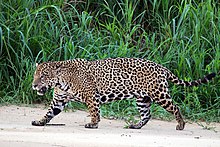






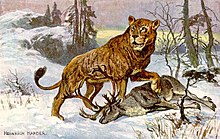

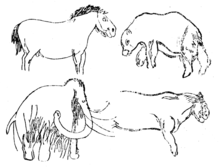


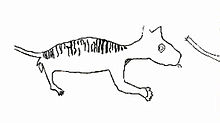
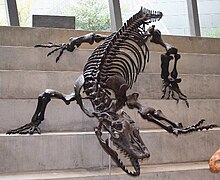
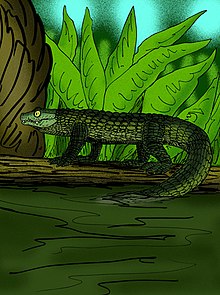

No comments:
Post a Comment